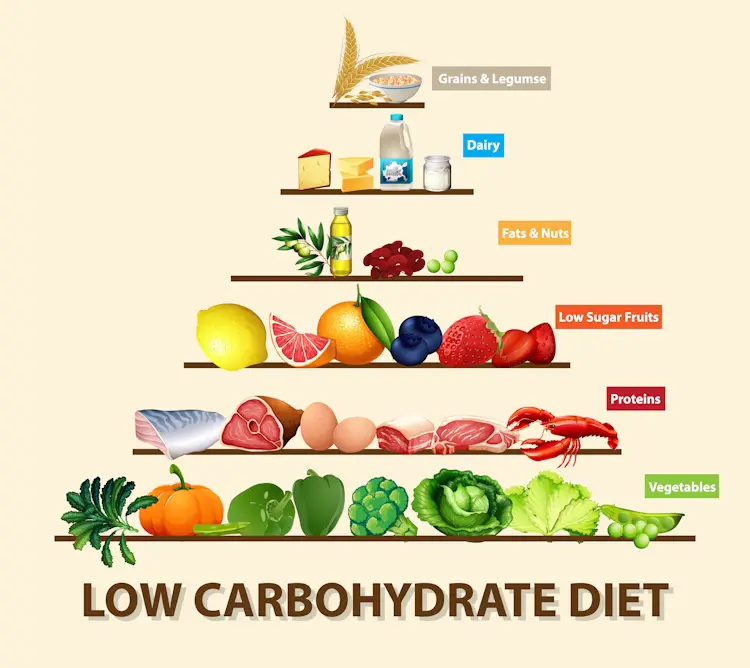Confused about carbs? You’re not alone—many people struggle to figure out how carbohydrates fit into a healthy diet. Carbs are a key energy source, but eating the wrong kinds can harm your health.
Thank you for reading this post, don't forget to subscribe!This blog will help you cut through the confusion and find what works best for you. Keep reading—you’ll see it’s simpler than you think!
Key Takeaways
- Carbs are the body’s main energy source. Simple carbs digest quickly but may spike blood sugar, while complex carbs provide steady energy and include fiber for gut health.
- Low-carb diets can help manage weight and conditions like type 2 diabetes by reducing insulin spikes and promoting fat-burning instead of glucose use.
- Studies show eating high-glycemic foods increases BMI, while low-carb plans with <50 grams daily improve metabolic health over time (Dr. Eric Westman).
- Adjust carb intake based on goals, activity level, or health needs. Athletes may need more carbs than sedentary individuals. Use tools to track meals and responses.
- Avoid hidden sugars in processed foods like sauces or bread; choose whole food sources such as vegetables, fruits, or legumes for balanced nutrition.
Understanding Carbohydrates
Carbohydrates are a key part of what gives your body energy. They come in different forms, which affect how they work and fuel you.
Types of carbohydrates: Simple vs. Complex
Simple carbohydrates have one or two sugar units. Examples include glucose, fructose in fruits, and sucrose found in table sugar. These digest quickly and provide fast energy but can spike blood sugar levels.
Complex carbohydrates are made of many sugar units linked together. Foods like whole grains, beans, and non-starchy vegetables contain these carbs. They take longer to digest, offer steady energy, and include fiber—important for gut health.
Simple carbs burn fast; complex ones fuel you longer.
Role of carbs in energy production
Carbohydrates fuel the body. They break down into glucose during digestion, which enters the bloodstream. Insulin then carries this glucose to cells, where it’s burned as energy. The brain and muscles rely heavily on this process to function well.
Complex carbs, like those in non-starchy vegetables and whole grains, provide steady energy. Unlike simple sugars, they digest slowly and keep blood sugar stable. This results in longer-lasting energy without spikes or crashes.
Carbohydrates and Metabolic Health
Carbohydrates affect your body’s sugar and insulin levels directly. Eating the right type of carbs can help with weight control and overall health.
Impact of carbs on insulin levels
Eating high-glycemic foods, like white bread or sugary snacks, can spike insulin levels quickly. The Carbohydrate-Insulin Model (CIM) explains that these spikes lead to increased insulin release.
High insulin encourages the body to store more fat and prevents fat burning. This can cause hunger and cravings soon after eating.
Low-carb diets help manage blood sugar and reduce these sharp rises in insulin. Studies show they may control weight better than high-carb diets over time. For those with type 2 diabetes or insulin resistance, cutting back on refined carbs can improve metabolic health significantly.
Managing carb intake is key for steady energy and healthy metabolism. – Dr. Eric Westman
Connection between carbs and weight management
Carbs play a big role in weight management. Eating too many high-glycemic carbs can lead to higher body fat. A study with 572 adults showed that a higher glycemic index increased BMI by 0.75 units.
Participants who got 44.9% of their calories from carbs had an average BMI of 27.4 kg/m², showing how carb intake affects overall weight.
Lower-carb diets, like the ketogenic diet, may help some people lose weight faster. These diets reduce insulin spikes and encourage fat-burning for energy instead of glucose. Dr. Eric Westman promotes low-carb living at his Keto Medicine Clinic to address issues like obesity or type 2 diabetes through controlled carbohydrate intake plans designed for better metabolic health outcomes.

Determining Your Carb Needs
Your carb needs depend on your body and lifestyle. Everyone has a different tolerance, so finding what works best takes patience and observation.
Factors affecting carb tolerance
Carb tolerance varies based on factors like age, activity levels, and genetics. Insulin resistance or conditions like type 2 diabetes can lower your ability to handle carbs. A person with insulin resistance may experience spikes in blood sugar even after eating a small amount of carbohydrates.
Digestive health also plays a role. Issues like SIBO or lacking enough digestive enzymes can cause poor carb digestion—leading to bloating, brain fog, or fatigue. Trying diets such as low-FODMAP for about a month might help identify triggers and improve symptoms linked to carbohydrate malabsorption.
How to identify your ideal carb intake
Finding the right amount of carbs for your body can feel tricky. Follow these steps to pinpoint what works best for you.
- Track your meals and energy. Keep a food diary or use apps like Google Play’s keto plan tools. Note how many carbs you eat daily and how it impacts your energy, focus, or hunger.
- Monitor health markers. Check blood sugar levels, weight, or signs like joint pain and skin problems weekly. Changes could signal if carb intake needs adjusting.
- Start with a baseline intake. For low-carb diets, aim for 20-50 grams daily as suggested by professionals like Dr. Eric Westman of the Keto Medicine Clinic.
- Gradually increase carbs weekly by 5-10 grams while monitoring changes like sugar cravings or energy dips.
- Consider activity levels. Athletes may tolerate more carbs due to physical performance demands compared to someone sedentary.
- Factor in metabolic health conditions such as type 2 diabetes, PCOS, or insulin resistance when setting limits to avoid blood sugar spikes.
- Observe signs of carb sensitivity like fat gain or sluggishness when adding more starchy foods such as non-organic grains.
- Adjust based on goals whether it’s fat loss (fewer carbs) or muscle building (higher intake). Adapting is key for long-term success.
- Choose quality sources such as non-starchy vegetables over processed sugars from products bought on Amazon.com or similar stores online.
- Consult an internal medicine doctor or obesity medicine specialist if unsure—professionals help refine plans for individual needs using science-backed strategies.
Common Misconceptions About Carbs
Many think all carbs are harmful, but that’s not true. Understanding the difference between types of carbs can help you make smarter food choices.
Debunking the “all carbs are bad” myth
Carbs are not the enemy. Whole food sources like fruits, vegetables, and whole grains provide essential nutrients. They fuel your body and brain. The RDA for carbohydrates is 130 grams daily, enough to maintain basic health.
Low-carb diets may work short-term but cutting all carbs isn’t needed for weight loss or better health. Complex carbs, like non-starchy vegetables and legumes, help control blood sugar levels.
Balanced carbohydrate intake can prevent cravings, improve energy, and reduce risks of chronic diseases like type 2 diabetes.
Clarifying the role of low-carb diets
Low-carb diets like the ketogenic diet focus on reducing carbohydrate intake to 15-30% of daily calories. This approach helps manage blood sugar levels and promotes weight loss, especially in people with type 2 diabetes or insulin resistance.
These diets often lead to quick initial weight loss because the body uses up glycogen stores, which releases stored water.
Dr. Eric Westman from Duke University has shown that low-carb lifestyles can improve metabolic health and reduce cravings for sugary foods. By cutting back on carbs, many experience better energy and fewer issues like joint pain or skin problems.
The next step is determining how much carbohydrate intake works best for you….
Customizing Your Carb Intake
Your body’s carb needs can change based on your goals and health. Adjust your intake to match weight loss, energy, or performance priorities.
Adjusting carbs for weight loss
Cutting carbs can help with weight loss. It works by limiting sugar spikes and pushing the body to burn fat.
- Start with Phase 1 of a low-carb plan, like the “page 4 diet,” which promotes rapid weight loss through nutritional ketosis. Eat unlimited meats, fish, eggs, and most cheeses while avoiding grains, sugars, fruits, and starchy vegetables.
- Lower daily carbohydrate intake to under 50 grams. This helps reduce blood sugar levels and improves insulin resistance.
- Choose non-starchy vegetables instead of high-carb options like potatoes or corn. Broccoli, spinach, and zucchini are low-carb picks.
- Avoid processed foods and hidden sugars in sauces or packaged snacks. These can stall fat-burning efforts without you realizing it.
- Focus on eating whole foods rich in fats and proteins, such as grass-fed meats or wild-caught fish. These support steady energy levels.
- Track your progress weekly by measuring waist size or using a scale but avoid obsessing over minor fluctuations.
- Drink plenty of water to stay hydrated during carb restriction as dehydration can cause fatigue or joint pain.
- Cut sugar cravings by adding healthy fats into meals like avocados or nuts—this keeps you full longer too!
- Gradually increase carbs once goals are met if needed for maintenance but stick to unprocessed sources like quinoa or berries.
Let’s now explore modifying carbs for maintenance or performance…
Modifying carbs for maintenance or performance
Keeping the right carb intake can help maintain weight or boost performance. Adjusting carbs depends on your body’s needs and goals.
- Increase total carbohydrates slightly for maintenance while staying under 50g daily if following a low-carb lifestyle. Add vegetables like broccoli, zucchini, or spinach, which are low in starch.
- Include healthy fats with your meals when adding more carbs for balance and steady energy levels. Try avocados, nuts, or seeds to avoid blood sugar spikes.
- Use non-starchy vegetables during meals to support long-term health and keep insulin resistance in check.
- Choose berries if you need extra natural sugar for workouts or recovery since they are nutrient-rich but low in carbs.
- Add small quantities of higher-fat dairy products like cheese or cream to fit into keto plans without exceeding limits.
- Focus on whole foods like grass-fed meats or organic eggs for protein alongside controlled carbohydrate intake for strength training days.
- Adjust carbohydrate intake based on activity level—low activity might require fewer carbs compared to high-performance days involving intense exercise routines.
A proper plan will also support better energy levels while aiding metabolic health…
Practical Tips for Managing Carbs
Planning meals with the right carbs can help you stay on track. Watch out for sneaky sugars hidden in processed foods—they add up fast!
Meal planning with balanced carbs
Include lean proteins like broiled salmon with asparagus for a balanced Phase 1 meal. For Phase 2, try spaghetti squash with meatballs—full of flavor but low in processed carbs. Combine healthy fats and non-starchy vegetables to stay within your carb threshold.
Seafood risotto works well in Phase 3, offering more flexibility while still controlling carbohydrate intake. Avoid hidden sugars by reading labels carefully—sauces and dressings often sneak sugar into meals.
Stick to whole foods to reduce insulin resistance and support weight management goals effectively.

Recognizing hidden sugars and processed carbs
Packaged foods often hide sugars and processed carbs under tricky names. Sugar can show up as sucrose, fructose, or high-fructose corn syrup. Foods labeled “low-fat” or “healthy” may still contain these hidden ingredients.
Even savory items like sauces, dressings, and bread sneak in extra sugar.
Processed carbs quickly turn into sugar when digested. White bread, crackers, and chips are big culprits. These cause blood sugar spikes that lead to cravings later on. Check labels carefully to spot these sneaky additives before they derail your low-carb living plan…
Leading next to balanced meal planning with healthier carb choices!
Benefits of Carb Awareness
Understanding carbs helps you make smart food choices. It can boost your energy and support better overall health.
Improved energy and mental clarity
Lowering carbohydrate intake can sharpen focus and boost energy. Eating very few carbs, like 20 grams or less daily during Phase 1 of a low-carb diet, reduces insulin levels. This stops blood sugar spikes and crashes that cause fatigue and brain fog.
A ketogenic diet helps the brain use fat for fuel instead of sugar. It keeps energy steady throughout the day. Many find they think more clearly after starting this kind of eating plan.
Reduced risk of chronic diseases
A balanced carb intake can lower the chances of serious illnesses like type 2 diabetes and high blood pressure. Low-carb diets help control insulin resistance, a key factor in these diseases.
Studies show they also improve metabolic health and aid in weight management, both crucial for long-term wellness.
Eating fewer processed carbs may reverse conditions such as PCOS and metabolic syndrome. This approach reduces risk factors like obesity and high cholesterol, which are linked to heart disease.
Choosing whole foods over sugary snacks supports better blood sugar control, promoting optimal health over time.
Conclusion
Carbs don’t have to be confusing. Learning how they work can help you make better choices for health and energy. Focus on whole foods, avoid too much sugar, and find the right balance for your body.
Small changes in your diet can improve weight management and overall wellness. Take control of your carb intake today!
